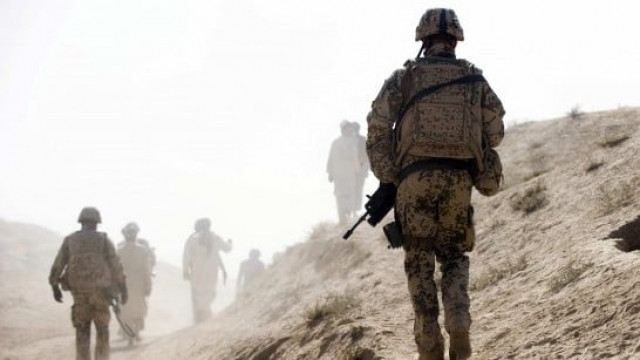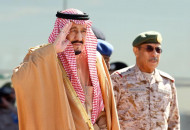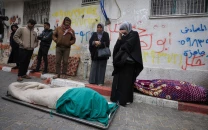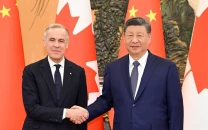US leaves its epicentre of Afghan war
American forces hand over Bagram Airfield to Afghan govt

US troops pulled out of the epicentre of their war in Afghanistan on Friday, leaving behind a piece of the World Trade Center they had buried there 20 years and bringing an effective end to America’s longest war in history.
The US handed over the Bagram Airfield to the Afghan National Security and Defence Force in its entirety, top American officials confirmed, as fears grow that the country might descend into a civil war after all the foreign forces leave the country.
“All American soldiers and members of NATO forces have left the Bagram airbase,” a senior US security official said in Kabul, speaking on condition of anonymity. However, a few more troops have yet to withdraw from another base in the capital Kabul.
Read more: Taliban claim overrunning five districts in Afghanistan
President Joe Biden, who had officially set a deadline of September 11 for the final pull-out, dampened speculation that the complete withdrawal of foreign forces from the country was imminent. “No. We’re on, we’re on track exactly as to where we expect to be,” he told reporters at the White House.
The base, taken over by the US forces in the winter of 2001 to oust the Taliban and hunt down the Al Qaeda perpetrators of the 9/11 terrorist attacks on America, is an hour’s drive north of Kabul. It was used by the US military to coordinate its air war and logistical support for its entire Afghan mission.
It was at Bagram, a bullet-ridden Soviet-built air strip on a plain hemmed in by the snow-capped peaks of the Hindu Kush, that New York City firefighters and police were flown to bury a piece of the World Trade Center in December, 2001, days after the Taliban were toppled.
It was also here that the CIA ran a “black site” detention centre for terrorism suspects and subjected them to abuse that former US president Barack Obama – under whose administration the US forces killed the main culprit of 9/11 attacks, Osama bin Laden – subsequently acknowledged as torture.
In later years, the airbase swelled into a sprawling fortified city for a huge international military force, with fast food joints, gyms and a cafe serving something called “the mother of all coffees”. Its two runways perpetually roared as presidents flew in and gave speeches; celebrities came and told jokes.
The vacation of the base comes about two months ahead of the timetable set by Biden – the 20th anniversary of the attacks on the American soil that brought the US troops to Afghanistan. The US had agreed to withdraw in last year’s deal with the Taliban under Biden’s predecessor Donald Trump.
‘Farewell call’
An Afghan official said the base would be officially handed over to the government at a ceremony on Saturday (today). A US defence official said Gen Austin Miller, the top US commander in Afghanistan, “still retains all the capabilities and authorities to protect the force” stationed in the capital, Kabul.
On Friday, Miller met Afghan President Ashraf Ghani and according to a Dari-language tweet by the presidential palace, the two discussed “continued US assistance and cooperation with Afghanistan, particularly in supporting the defence and security forces”.
There were no specifics but the US is already committed to paying nearly $4 billion annually until 2024 to finance the Afghan security forces. While no one was calling Miller’s visit a farewell, against the backdrop of the evacuation of the airfield it had the hallmarks of a goodbye.
Taliban welcome
Earlier this week, Miller told journalists in Kabul that a civil war for Afghanistan was “certainly a path that can be visualised”, with Taliban fighters sweeping into districts around the country in recent weeks as foreign troops flew home.
The Taliban welcomed the American withdrawal from Bagram Airfield. “We consider this withdrawal a positive step. Afghans can get closer to stability and peace with the full withdrawal of foreign forces,” Taliban spokesman Zabihullah Mujahid told Reuters.
‘Extensive process’
US military spokesman Col Sonny Leggett said that the handover was an “extensive process” that spanned over several weeks and began soon after President Biden’s mid-April announcement that America was withdrawing the last of its forces.
“All handovers of Resolute Support bases and facilities, to include Bagram Airfield, have been closely coordinated, both with senior leaders from the government and with our Afghan partners in the security forces, including leadership of the locally based units respective to each base,” Col Leggett said.
However, the district administrator for Bagram, Darwaish Raufi, said the American departure was done overnight without any coordination with local officials, and as a result early on Friday, dozens of local looters stormed through the unprotected gates before Afghan forces regained control.
“They were stopped and some have been arrested and the rest have been cleared from the base,” Raufi told The Associated Press, adding that the looters ransacked several buildings before being arrested and the Afghan forces took control.
“Unfortunately, the Americans left without any coordination with Bagram district officials or the governor’s office,” Raufi said. “Right now, our Afghan security forces are in control both inside and outside of the base.”
The deputy spokesman for Afghanistan’s defence minister, Fawad Aman, said nothing of the early morning looting. He said only the base had been handed over and that Afghan forces would now “protect the base and use it to combat terrorism”.
No fanfare
The withdrawal is the clearest indication that the last of the 2,500-3,500 US troops have left Afghanistan or are nearing a departure. US security officials had said this week that the majority of US military personnel would most likely be gone by July 4, with a residual force remaining to protect the embassy.
As of this week, most other NATO soldiers had already exited Afghanistan quietly. Announcements from several countries showed that a majority of European troops have left with little ceremony — a stark contrast to the public show of force when they backed the US invasion in 2001.
Simultaneously, several European nations were also providing refuge to hundreds of Afghan employees and their families as they faced direct threat from the Taliban. A senior western diplomat said the US has asked three Central Asian nations – Kazakhstan, Tajikistan and Uzbekistan – to temporarily provide home to about 10,000 Afghan citizens, who had either worked with the US or allied forces.
The US has refused to say when the last American soldier would leave Afghanistan, citing security concerns, but also future security and protection for Kabul International Airport is still being negotiated. Turkish and US soldiers are currently protecting the airport, still under the Resolute Support Mission.
Until a new agreement for the airport is struck by Turkey and the Afghan government, and possibly the United States, it appears the Resolute Support Mission, which is the military mission being wound down, would have to continue to be in charge of the facility.
Worrying development
The US will still have about 650 troops in Afghanistan to protect its sprawling embassy in Kabul. Their presence is understood will be covered under a bilateral agreement with the Afghan government, according to the US officials.
The US and NATO departure comes amid a worrying development that the Taliban have been making strides in several parts of the country, overrunning dozens of districts and overwhelming beleaguered Afghan security forces.
However, the more worrying development is that the government has resurrected militias with a history of brutal violence to assist Afghan security forces. At what had all the hallmarks of a final press conference, Gen Miller this week warned that continued violence risked a civil war in Afghanistan.
The Taliban have launched relentless offensives across Afghanistan in the past two months, gobbling up dozens of districts as Afghan security forces have largely consolidated their power in the country’s major urban areas.
At the White House, Biden responded to concerns that the internationally-backed Afghan government might quickly crumble to Taliban insurgents once its foreign backers leave, saying they “have the capacity to be able to sustain government down the road”.
Bagram history
Bagram includes three large hangars, a control tower and numerous support buildings, according to GlobalSecurity, a security think tank. The base has a 50-bed hospital with a trauma bay, three operating theatres and a dental clinic. Another section houses a prison, notorious and feared among Afghans.
Bagram was built by the United States for its Afghan ally during the Cold War in the 1950s as a bulwark against the Soviet Union in the north. Ironically, it became the staging point for the Soviet invasion of the country in 1979, and the Red Army expanded it significantly during its near-decade-long occupation.
When Moscow pulled out, Bagram became central to the raging civil war in the 1990s—it was reported that at one point the Taliban controlled one end of the three-kilometre runway and the opposition Northern Alliance the other.
When the US and NATO inherited Bagram in 2001, they found it in ruins, a collection of crumbling buildings, gouged by rockets and shells, most of its perimeter fence wrecked. It had been abandoned after being battered in the battles between the Taliban and rival warlords.
The airbase now has two runways. The most recent, at 12,000 feet long, was built in 2006 at a cost of $96 million. There are 110 revetments, which are basically parking spots for aircraft, protected by blast walls.
In recent months, Bagram has come under rocket barrages claimed by the Islamic State, stirring fears that militants are already eyeing the base for future attacks. As of May 2021, there were about 9,500 foreign troops in Afghanistan, of which US troops made up the largest contingent of 2,500.
Russia, meanwhile, cautioned on Friday that the US and NATO troop withdrawal from Afghanistan must not turn into a redeployment of the alliance’s military infrastructure in Central Asia, the RIA news agency reported.



















COMMENTS
Comments are moderated and generally will be posted if they are on-topic and not abusive.
For more information, please see our Comments FAQ